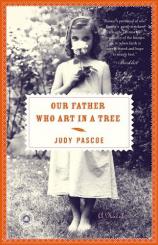Reading Group Guide
Discussion Questions
Our Father Who Art in a Tree

1. Our Father Who Art in a Tree is full of humor that lightens the novel and gives the reader the sense that there is levity in the grieving process. Do you think the author's background as a stand-up comedienne has allowed her to see the humor in even the most solemn situations? Explore ways in which you use humor in your own life to deal with difficult situations. Do you find Pascoe's method to be effective?
2. Although told from a child's perspective, Our Father Who Art in a Tree is a very mature look at several life changing processes, namely, coming-of-age and grieving. Did you find that you had to get in touch with your own "inner-child" through Simone when reading this book? How does the simple observations of a child lend an added layer of wisdom to the story?
3. Our Father Who Art in a Tree is full of fantastical, mystical elements that are counterbalanced by the most ordinary aspects of real, daily life. Discuss where the author finds the appropriate balance between fantasy and reality in this book making it both accessible and believable?
4. Compare the different members of Simone's family and how they deal with the passing of her father? Why do you think her mother chooses to stare blankly into space and her brother throws himself into his school assignments? Do you think Simone's way of coping is healthier and more productive?
5. Why do you think Pascoe chooses a tree as the means through which Simone's father would speak to her? Why do you think Simone's mother initially wants to keep the secret of climbing high into the tree a secret?
6. After the toilet is filled with frogs, Simone notices that the house seems to be falling apart since her father has died. "They were just part of the constant stream of misdemeanors committed by a house against its occupants," she observes. So much of this book is about nature and the passage of time and how it confronts and overwhelms the living. Identify instances of this throughout the novel. Do you feel that this an apt metaphor for life? Why or why not? Do you think there is a constant struggle between people and the homes and land they inhabit?
7. What does it mean when Simone's mother decides to take charge and clean the house? What does the presence of the drain man do to precipitate this sudden change in her mother?
8. At the end of the novel when Simone is grown and her mother has finished raising her children, her mother decides to sell the house. Simone says that she and the other children hated her for that act, but that they knew it was time for their mother to move on. Why do you think the house meant so much to the family and their identity? How is leaving the house represent moving on? What other symbols and metaphors does Pascoe employ to convey the passage of time and life transitions?
9. So much of Our Father Who Art in a Tree is about identity and how our relationship to our family, spouses, friends, and neighbors define how we view ourselves? How does the death of the father affect the family's identity? How does Simone and her mother in particular come to view themselves after the death?
Our Father Who Art in a Tree
- Publication Date: April 13, 2004
- Paperback: 224 pages
- Publisher: Random House Trade Paperbacks
- ISBN-10: 0375759875
- ISBN-13: 9780375759871






